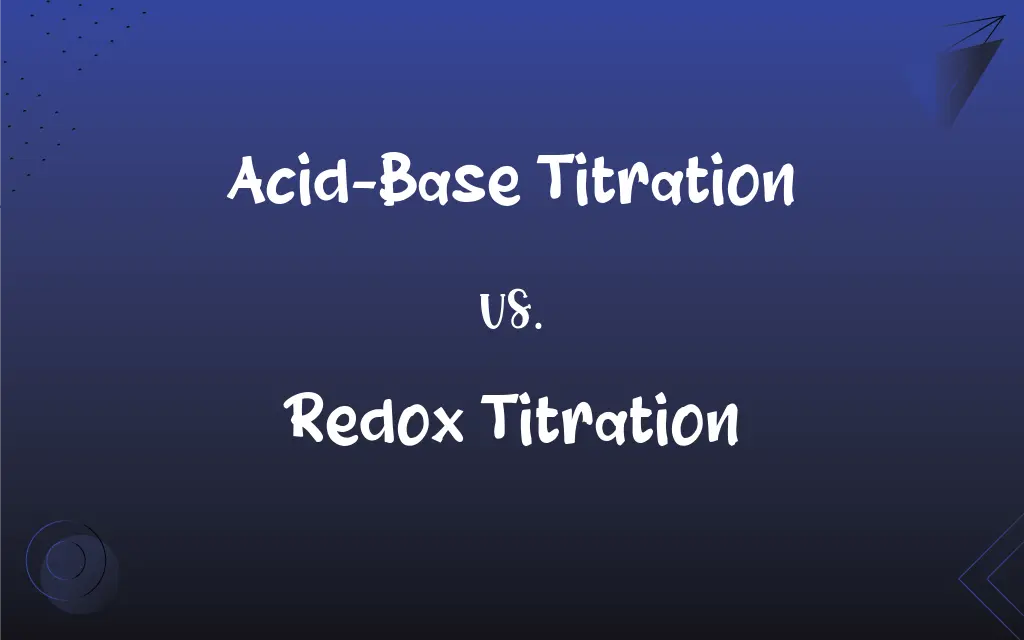Acid-Base Titration vs. Redox Titration: What's the Difference?
Edited by Aimie Carlson || By Harlon Moss || Updated on October 23, 2023
Acid-base titration determines concentration through neutralization reactions, while redox titration involves oxidation-reduction reactions.

Key Differences
Acid-base titration is a laboratory technique used to determine the concentration of an acid or a base by neutralizing it with a solution of known concentration. Redox titration, on the other hand, determines the concentration of a reducing or oxidizing agent by reacting it with an oxidizing or reducing agent of known concentration, respectively.
In acid-base titration, the endpoint is typically signaled by a pH indicator's color change. In redox titration, the endpoint might be indicated by a color change due to the presence of an indicator or through the use of a potentiometer.
Acid-base titration is governed by the principle that acids react with bases to form water and salt. In contrast, redox titration is based on the transfer of electrons between the titrant and the analyte, leading to oxidation and reduction processes.
The mathematical relationships in acid-base titration are built upon the concept of moles and equivalents of acid and base. In redox titration, the calculations often revolve around the concept of equivalents and electron transfer.
In practical applications, acid-base titration can be used, for example, in determining the amount of acidity or basicity in substances like vinegar or soap. Redox titration, however, finds uses in areas like determining the amount of vitamin C in a solution or the iron content in ore.
ADVERTISEMENT
Comparison Chart
Reaction Type
Neutralization
Oxidation-Reduction
Endpoint Detection
PH indicator's color change
Color change of an indicator or use of a potentiometer
Governing Principle
Acids react with bases to form water and salt
Transfer of electrons leading to oxidation and reduction
Calculation Basis
Moles and equivalents of acid and base
Equivalents and electron transfer
Practical Application
Determining acidity/basicity (e.g., in vinegar or soap)
Determining content of oxidizing/reducing agents (e.g., vitamin C)
ADVERTISEMENT
Acid-Base Titration and Redox Titration Definitions
Acid-Base Titration
It's a quantitative analysis technique for acids and bases.
Through acid-base titration, the lab identified the molarity of the hydrochloric acid sample.
Redox Titration
It involves reactions where electrons are transferred between the titrant and analyte.
During the redox titration, the iron(II) solution was oxidized to iron(III).
Acid-Base Titration
Acid-base titration relies on the formation of water and salt during neutralization.
The salt formation confirmed the completion of the acid-base titration process.
Redox Titration
Redox titration can use potentiometry or color indicators for endpoint detection.
The change in the potassium permanganate's purple color indicated the endpoint in the redox titration.
Acid-Base Titration
It involves neutralizing an acid or base with a solution of known concentration.
Acid-base titration allowed us to neutralize the unknown base with a standard acid solution.
Redox Titration
Redox titration calculations revolve around the transfer of specific numbers of electrons.
The redox titration revealed that two electrons were transferred per molecule during the reaction.
Acid-Base Titration
Acid-base titration uses pH indicators to signal the endpoint.
During the acid-base titration, the phenolphthalein indicator turned pink, indicating the endpoint.
Redox Titration
Redox titration determines the concentration of a reducing or oxidizing agent.
Redox titration helped ascertain the vitamin C content in the orange juice.
Acid-Base Titration
Acid-base titration is a method to measure the concentration of an acid or a base.
Using acid-base titration, the strength of a vinegar solution was determined.
Redox Titration
It's a quantitative method based on oxidation and reduction reactions.
Redox titration allowed for the quantification of iron in the ore sample.
FAQs
How do you detect the endpoint in a redox titration?
In redox titration, the endpoint can be detected using specific indicators or a potentiometer.
What's the primary purpose of acid-base titration?
Acid-base titration determines the concentration of an acid or a base.
Which indicator is commonly used in acid-base titration?
Phenolphthalein is a commonly used indicator in acid-base titration.
What's the main reaction type in redox titration?
The main reaction type in redox titration is oxidation-reduction.
Can redox titration be used for organic compounds?
Yes, redox titration can be applied to certain organic compounds that undergo oxidation or reduction.
How can you increase the accuracy of an acid-base titration?
To increase accuracy in acid-base titration, ensure precise measurements, use a suitable indicator, and repeat titrations for consistency.
What's the significance of the equivalence point in acid-base titration?
The equivalence point in acid-base titration is when the moles of acid equal the moles of base, indicating complete neutralization.
Is it necessary to know the concentration of one solution in acid-base titration?
Yes, in acid-base titration, the concentration of either the acid or the base must be known to determine the other's concentration.
How is redox titration different from acid-base titration?
Redox titration involves oxidation-reduction reactions, while acid-base titration involves neutralization reactions.
Can acid-base titration be used to determine the pH of a solution?
Yes, acid-base titration can be used to determine the pH or pOH of a solution.
Are burettes used in both acid-base and redox titration?
Yes, burettes are commonly used in both acid-base and redox titration to deliver the titrant.
Can both strong and weak acids be titrated in acid-base titration?
Yes, both strong and weak acids can be titrated in acid-base titration.
What's a common application of redox titration?
A common application of redox titration is determining the vitamin C content in solutions.
Why is the endpoint color sometimes faint in redox titration?
The endpoint color in redox titration might be faint if the indicator is not strongly colored or if the concentration of the titrant is low.
Is it necessary to use a catalyst in redox titration?
In some redox titrations, a catalyst might be added to speed up the reaction, but it's not always necessary.
Can acid-base titration be used to determine the strength of an acid?
Yes, acid-base titration can determine the molar concentration or strength of an acid.
What role does the stoichiometry play in redox titration?
Stoichiometry in redox titration helps in determining the relationship between the amount of titrant used and the amount of analyte present.
What type of reactions occur in redox titration?
In redox titration, electrons are transferred, leading to oxidation and reduction reactions.
Do acid-base titrations always produce water?
Yes, in acid-base titrations, the neutralization of an acid with a base typically produces water.
How do you choose an indicator for acid-base titration?
The indicator for acid-base titration is chosen based on the pH at the equivalence point.
About Author
Written by
Harlon MossHarlon is a seasoned quality moderator and accomplished content writer for Difference Wiki. An alumnus of the prestigious University of California, he earned his degree in Computer Science. Leveraging his academic background, Harlon brings a meticulous and informed perspective to his work, ensuring content accuracy and excellence.
Edited by
Aimie CarlsonAimie Carlson, holding a master's degree in English literature, is a fervent English language enthusiast. She lends her writing talents to Difference Wiki, a prominent website that specializes in comparisons, offering readers insightful analyses that both captivate and inform.































































